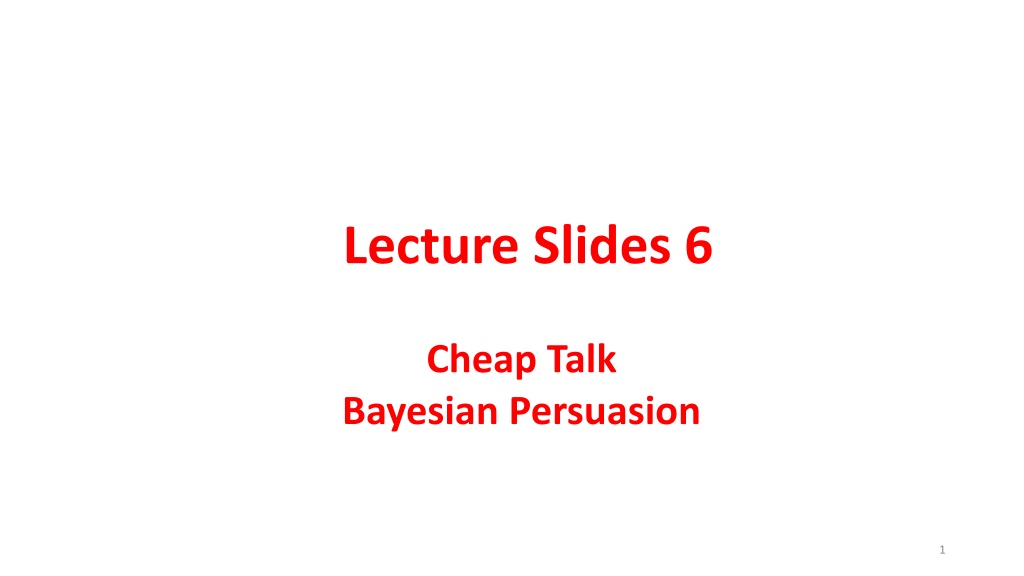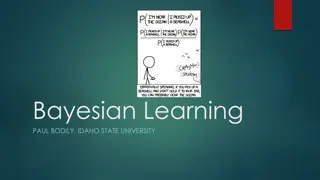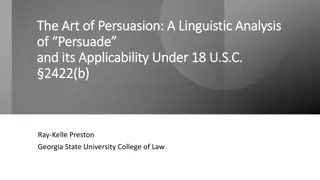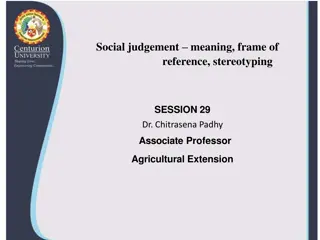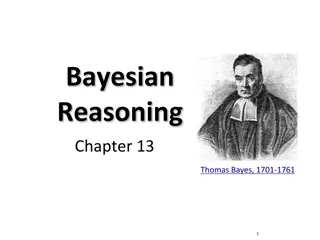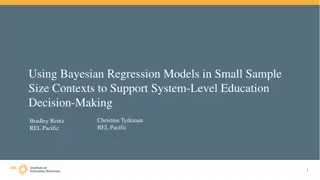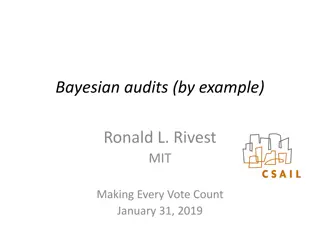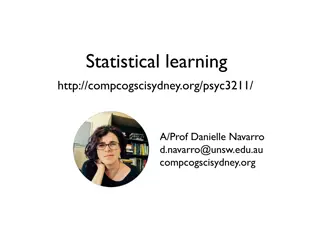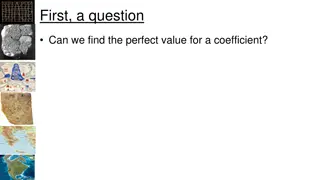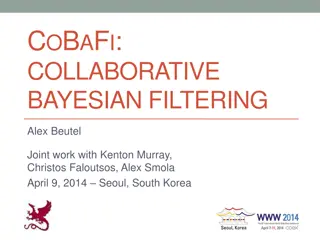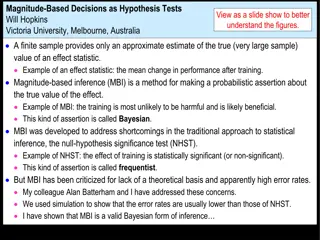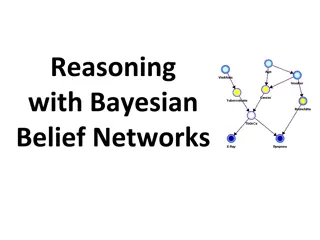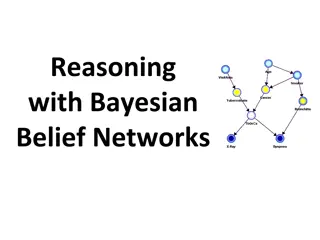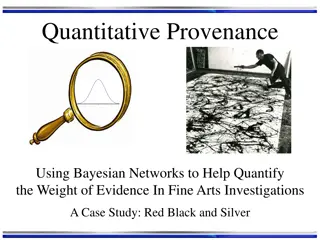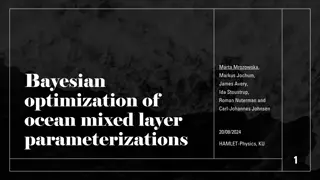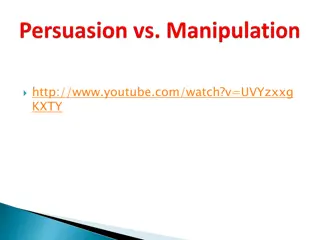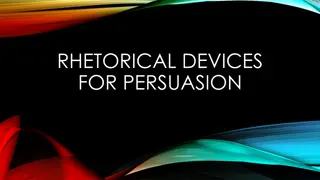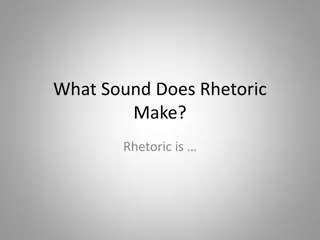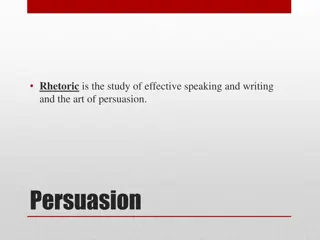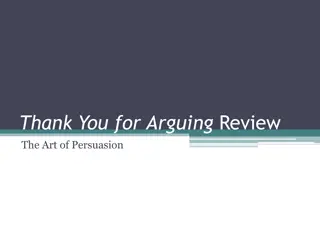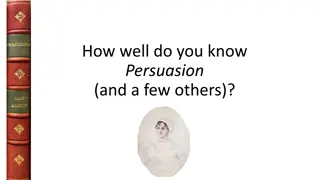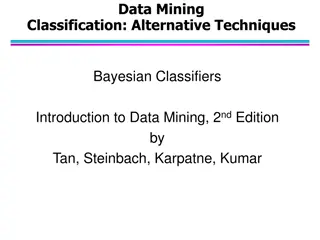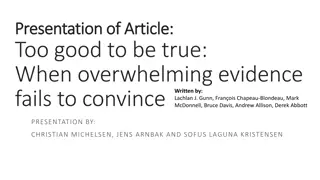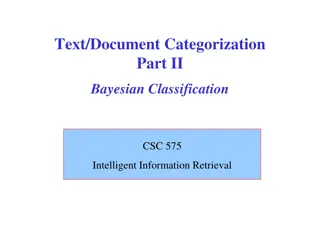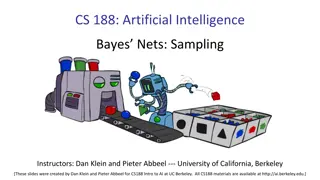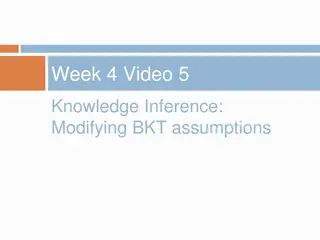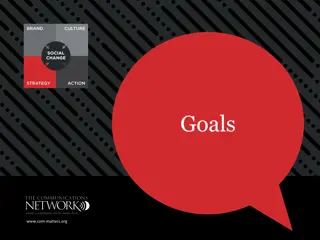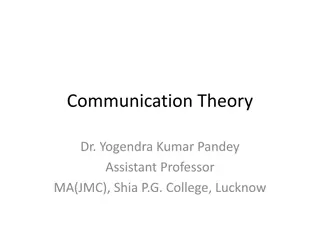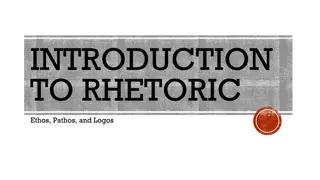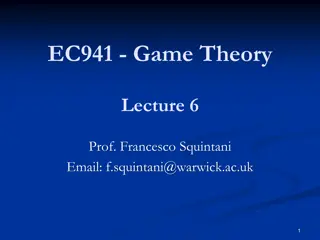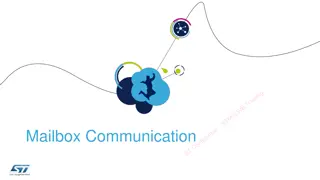Strategic Communication in Bayesian Persuasion
Understanding the concepts of cheap talk and Bayesian persuasion in strategic communication, where information can be conveyed via direct communication even in the presence of conflicts of interest. Explore how biased senders influence noisy communication, and analyze communication equilibria in scenarios such as project profitability discussions and decision-making between managers and CEOs based on private information.
- Strategic Communication
- Cheap Talk
- Bayesian Persuasion
- Information Transmission
- Communication Equilibria
Download Presentation

Please find below an Image/Link to download the presentation.
The content on the website is provided AS IS for your information and personal use only. It may not be sold, licensed, or shared on other websites without obtaining consent from the author. Download presentation by click this link. If you encounter any issues during the download, it is possible that the publisher has removed the file from their server.
E N D
Presentation Transcript
Lecture Slides 6 Cheap Talk Bayesian Persuasion 1
Outline: Ways that (strategic) information can be transmitted: 1. Cheap talk. 2. Bayesian Persuasion. 2
1. Cheap Talk (Strategic Communication) When information is unverifiable and signalling or contracts are not feasible, can we still convey information via direct communication despite conflicts of interest? The sender has access to information while the receiver is the one who will take a decision. Why cheap talk : Providing and receiving information is completely free. There are no direct costs to lying. => A costless signalling game! 3
Applications: Project manager communicating to a CEO about a project s profitability. An entrepreneur communicating to potential investors about his innovation s value. A supervisor giving information about an employee to a manager. Lobbyist advising to a politician about the expenditure on a public project. Salesman advising a customer about a product's quality. Important feature: ``bias i.e. conflict of interest. Information is not verifiable. 4
Communication is trivial when interests are aligned! When interests are misaligned, only noisy (imperfect) information can be communicated! The more biased the sender is, the more noisy communication. Then, the question is whether informative communication equilibria exist? 5
CEO and division manager Division manager CEO Success Failure Success Failure 5+B 5 10 Yes 10 0 0 0 0 No When ? > ?, the Project manager is biased towards implementing projects compared to the CEO (conflict of interest). But, both of them dislike a failed project (some degree of common interest). 6
Assume that the manager has private information about the projects success probability, ?, while the CEO only knows ?~?[0, ?]. ?? There is a threshold ??= project, while for the CEO this threshold is ??=? ?+?? above which the manager wants to implement a ?> ??. 7
A communication equilibrium: It is enough to consider 2 types of messages in this setup: one that suggests to implement (or says high) and another that suggests not to Implement (or says low). Manager will suggest to not implement the project whenever ? < ??= , the CEO will always follow this advice as ? < ??< ??. 8
What about when the manager suggests to implement? The manager wants the CEO to implement the project whenever ? ??. Then, whenever the manager suggests to implement the project, the CEO now believes ? ??,? which leads to the following posterior of the CEO: ??+? ? E ? ? ?? = 9
In that case, there are two possibilities: 1. The CEO will listen to the advice if and only if: ??+1 2 3: ``I 2 know you are exaggerating but still I find it optimal to follow your advice! => rubber stamp! Both actions can be induced. 2. The CEO doesn t follow the advice if: ??+1 <2 3 . ``My 2 belief about the project quality has increased but not sufficiently to approve. The CEO never ends up implementing. Manager s advice doesn t affect CEO s choice! 10
1. ??+1 2 3 if B 15 2 Interests are sufficiently aligned (B not too high) => cheap talk is credible! 2.??+1 <2 3 if B> 15 2 When B high enough => Whether manager suggests to implement or not doesn t affect the receiver s decision (although it may affect his belief, but not his action). Communication cannot influence the outcome. 11
A buyer seller relationship: Could be a salesman and a buyer. The salesman knows the quality of his product. If the real quality of the product is v the buyer would be willing to pay p=v, whereas the seller wants to make the buyer believe it is v+b. b cannot be too high as the buyer may come back to the shop and fight! No truth telling equilibrium: seller always exaggerates. Then, the buyer discounts every claim that the seller makes. The extent of exaggeration (b) depends on if customer is a regular one or just a passer-by! 12
As b (bias) increases, less number of credible claims: more conflict of interest leads to less effective (more noisy) communication. When b is above a threshold => no meaningful communication at all! ``babbling equilibrium : The seller always says this is the best meat you can find! The buyerthinks: I don t care what you say, as you always say the same thing! 13
Conclusions Cheap talk studies a communication game in which there is a degree of conflict of interest, but also some alignment of preferences. The main assumption is that the sender has access to information for free, communication has no direct cost and there is no room for contracts! There is meaningful communication if and only if the bias (conflict of interest) is sufficiently low. The truthfulness of communication decreases in the bias parameter. 14
References:(for further interest). Canonical: Crawford and Sobel (1982), ``Strategic Information Transmission . Recent Survey: Sobel (2013), ``Giving and Receiving Advice . Organizational Design: Dessein, W. (2002), ``Authority and Communication in Organizations . Alonso and Matouschek (2008). ``Optimal Delegation . Alonso, Dessein and Matouschek (2008). ``When Does Coordination Require Centralisation . 15
2. Bayesian Persuasion Strategic communication between two people: a sender and a receiver. There is an underlying truth, about which the two initially share a common prior. The sender is trying to persuade the receiver to take a certain action, regardless of the state of the world. The receiver only wants to take that action if a certain state of the world is realised. The sender announces and commits to a signalling strategy, without any further information about the state. The receiver observes the information (a signal realisation) and then takes an action. 16
CEO and division manager Division manager CEO Success Failure Success Failure 5 10 10 Yes 10 0 0 0 0 No Assume the project has one of two success probabilities: ? = 0.8 and ??= 0.6, which are equally likely. 17
The manager wants to implement the project whenever ? 1 2 CEO wants to implement whenever ? 2 3 Either type of project is acceptable for the manager, whereas the CEO only would like to implement if ? = ? . With only cheap talk available, can any credible communication take place? 18
Question: How often can the Manager make the CEO accept a low success project? Let s say Manager can be ``partially truthful as opposed to cheap talk only. 19
The manager commits to a revelation strategy: Whenever the project success is high, the manager sends high message. Whenever the project success is low, the manager sends high with probability ?, and low with 1 ?. Upon hearing high, what is the posterior of CEO that project has high success rate, ? ? (Bayes rule!) 0.5 0.5 + 0.5? The CEO implements project if the above is higher than 2 3. 20
The manager cannot send high message too often when the project success is low! Want to lie as much as possible subject to still being credible! Consider ? = 0.5.Upon hearing implement, the CEO s belief that ? = ? : 0.5 + 0.25=2 0.5 3 For CEO to listen to the Manager, we need ? 0.5 can lie at most half of the time when project success is indeed low! 21
Reference: Kamenica and Gentzkow (2010), ``Bayesian Persuasion . 22
